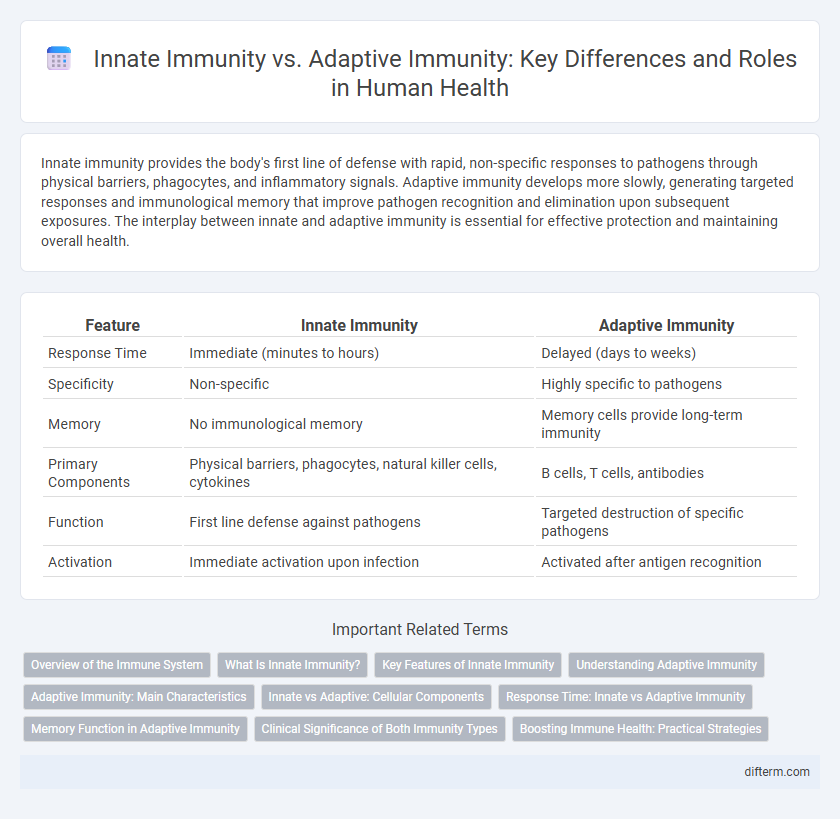Innate immunity provides the body's first line of defense with rapid, non-specific responses to pathogens through physical barriers, phagocytes, and inflammatory signals. Adaptive immunity develops more slowly, generating targeted responses and immunological memory that improve pathogen recognition and elimination upon subsequent exposures. The interplay between innate and adaptive immunity is essential for effective protection and maintaining overall health.
Table of Comparison
| Feature | Innate Immunity | Adaptive Immunity |
|---|---|---|
| Response Time | Immediate (minutes to hours) | Delayed (days to weeks) |
| Specificity | Non-specific | Highly specific to pathogens |
| Memory | No immunological memory | Memory cells provide long-term immunity |
| Primary Components | Physical barriers, phagocytes, natural killer cells, cytokines | B cells, T cells, antibodies |
| Function | First line defense against pathogens | Targeted destruction of specific pathogens |
| Activation | Immediate activation upon infection | Activated after antigen recognition |
Overview of the Immune System
The immune system comprises innate immunity, providing immediate, non-specific defense mechanisms such as physical barriers, phagocytes, and natural killer cells, and adaptive immunity, which develops targeted responses through lymphocytes like B cells and T cells after exposure to specific pathogens. Innate immunity acts as the first line of defense, rapidly recognizing common microbial patterns, while adaptive immunity generates immunological memory for faster and stronger reactions upon re-exposure. Together, these systems maintain homeostasis and protect the body from infections, with innate immunity triggering the adaptive response.
What Is Innate Immunity?
Innate immunity is the body's first line of defense against pathogens, consisting of physical barriers like skin, chemical barriers such as stomach acid, and immune cells including macrophages and neutrophils. This non-specific immune response acts rapidly upon infection, recognizing common microbial features through pattern recognition receptors. Unlike adaptive immunity, innate immunity does not confer long-lasting or antigen-specific protection but provides immediate and essential immune surveillance.
Key Features of Innate Immunity
Innate immunity provides the body's first line of defense through physical barriers like skin and mucous membranes, and cellular components including macrophages, neutrophils, and natural killer cells. It acts rapidly within minutes to hours upon pathogen exposure, relying on pattern recognition receptors to detect common microbial features. This immune response is non-specific, lacks memory, and serves to contain and eliminate invaders while activating the adaptive immune system.
Understanding Adaptive Immunity
Adaptive immunity involves specialized lymphocytes like T cells and B cells that recognize specific antigens and generate a targeted immune response. This immunity develops memory after initial exposure to pathogens, enabling a faster and stronger response upon subsequent encounters. It contrasts with innate immunity by providing specificity and long-lasting defense against infections.
Adaptive Immunity: Main Characteristics
Adaptive immunity is characterized by its ability to recognize specific antigens through highly specialized lymphocytes such as B cells and T cells, enabling targeted and efficient pathogen elimination. This immune response develops memory cells after initial exposure, allowing faster and stronger reactions upon subsequent encounters with the same antigen. Unlike innate immunity, adaptive immunity provides long-lasting protection and evolves with repeated antigen exposure.
Innate vs Adaptive: Cellular Components
Innate immunity relies on cellular components such as macrophages, neutrophils, dendritic cells, and natural killer cells that provide immediate, non-specific defense against pathogens. Adaptive immunity involves lymphocytes, mainly B cells and T cells, which offer highly specific responses and immunological memory. The interaction between dendritic cells and T cells bridges innate and adaptive immunity, facilitating antigen presentation and tailored immune reactions.
Response Time: Innate vs Adaptive Immunity
Innate immunity provides an immediate, non-specific defense against pathogens, activating within minutes to hours of exposure. Adaptive immunity, characterized by specificity and memory, takes days to weeks to develop a targeted response against particular antigens. The rapid action of innate immunity serves as the first line of defense, while adaptive immunity offers long-lasting protection through immunological memory.
Memory Function in Adaptive Immunity
Adaptive immunity features a specialized memory function that enables the immune system to recognize and respond more efficiently to previously encountered pathogens. Unlike innate immunity, which provides immediate but nonspecific defense, adaptive immunity develops specific antibodies and memory T cells after initial exposure. This immunological memory ensures faster and stronger responses upon subsequent infections, enhancing long-term protection.
Clinical Significance of Both Immunity Types
Innate immunity provides the first line of defense against pathogens through rapid, nonspecific responses, crucial for preventing early infection and limiting pathogen spread. Adaptive immunity offers targeted, long-lasting protection by generating specific antibodies and memory cells, which are essential for effective vaccination and immunity against recurrent infections. Clinical significance lies in leveraging innate immunity for immediate immune activation and adaptive immunity for durable, pathogen-specific protection in disease management and immunotherapy.
Boosting Immune Health: Practical Strategies
Innate immunity provides the body's first line of defense through barriers and non-specific responses, while adaptive immunity offers targeted responses via specialized cells like T and B lymphocytes. Effective strategies to boost immune health include adequate nutrition rich in vitamins C, D, and zinc, regular physical activity, and sufficient sleep to enhance both innate and adaptive functions. Stress management and avoiding smoking also play critical roles in maintaining immune system balance and improving overall resistance to infections.
Innate Immunity vs Adaptive Immunity Infographic

 difterm.com
difterm.com